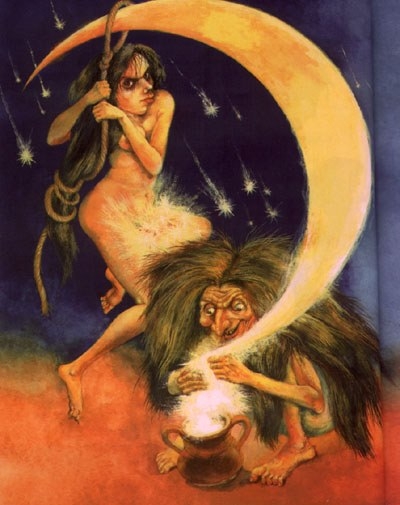The moon and wizards

Picture: Omda.bg
In folklore, the moon is magical and addressed as female. She is the sister of the sun, although in earlier notions the moon is a boy. In a song from the Strandzha village of Varshilo, at the sunny marriage with a "girl from Prezoryanche" the boy was invited to "become a godfather".
The moon rises at night, in the dark, and therefore many mysteries are connected with it. Its phases, its location, the lunar eclipse are explained by different beliefs.
The time from new moon to full moon is considered extremely favorable. When the news comes (the new moon) it is good to do nothing new and important - engagement, wedding, to start plowing, sowing, harvesting, threshing, to cut wood for building a house, to enter a new home, to shear the sheep, to sew a new garment ... If you were born at the new moon, you will be healthy, lucky and you will live long. The rash (after a full moon) is associated with failure.
According to the moon, the farmers orient themselves and make their meteorological forecast - if "her horns are up" and "her bedside table hangs", it will rain ...
There are also magical practices connected with it, among which, undoubtedly, the most interesting is its removal by magicians in a secret time against Easter or Midsummer's Day. No one has seen this, because there is a specific threat in the belief - if you just look, you will go crazy or dumb. It is believed that the removal of the moon happens like this: in the yard the sorceress puts a cauldron of water, inside - various herbs, and next to it - a new sieve. At midnight he leaves his house completely naked, holding a wrist in his hands, approaching the cauldron, saying something, looking at the moon. He enters his house, takes a pot and spells with it next to the cauldron. Then he takes the sieve, walks around the house three times, saying some words again. He puts the sieve over the cauldron, like a lid, dips his wrist in the pot and sprinkles the sieve itself, the yard in the four directions, himself and upwards, to the sky. Then the moon slowly begins to darken and seems to disappear. It is getting dark, and in the yard - bright as day - the moon has fallen into the sieve.
According to the ideas of the people in Strandzha, after the magicians removed the moon from the sky, they turned it into a cow, from which they milked "nine ments" milk. In this way they make their cows more dairy. This interpretation definitely has a practical, more
domestic character, a real, measurable result is sought. There is another option ... The sorceress raises the sieve over the cauldron and talks quietly and continuously with the moon. He then releases her so that she can slowly return to heaven. Tired of going down and up, for a while it may not shine as brightly and brightly as before, but it gradually recovers until it is "full."
And here, down on the ground, the first roosters are singing and everything looks the same. The sorceress is at home, already dressed and doing her usual activity - boiling herbs.
What has changed? Why did she make so much effort to force the moon to come down to earth? She has achieved her goal - she already knows everything that has happened in the world. It was told to her by the moon, which looks down from above, and at night, when all sorts of secret things are being done ...
Today we often say that good information is most important, it gives confidence, power and strength. Apparently, this has been the case since the dawn of time ...
References:
- Dimitar Marinov. Living Antiquity, Book One, Ruse, 1891, 49–52
- Rachko Popov. People's worldview. Cosmography and geography. In: Strandzha. Material and Spiritual Culture, BAS, Sofia, 1996, 217-218
- "Witches" - illustration of the artist Victor Paunov in the book of Kr. Mirchev "Vampires, Gunduraci, Dragon", Sofia, 1998. The photo is from Omda.bg
Rositsa Topalova
Curator in the Ethnography Department of RHM Burgas
